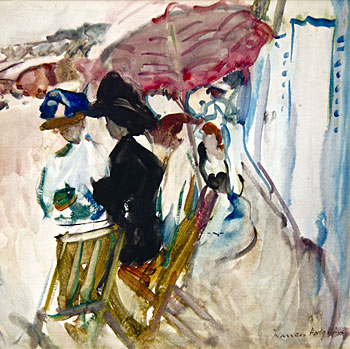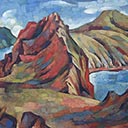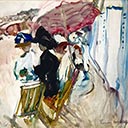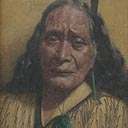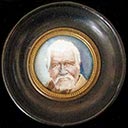Sur La Plage
30 x 31 cm
est. $55,000 - 70,000
Provenance: Private Collection, Auckland
In true classical manner, the body language of the figures and their summarily depicted facial expressions in Frances Hodgkins' watercolour Sur la Plage indicate the inner workings of the soul of four women.
Three women are grouped together. The female in the dark clothes dominates the conversation. She leans forward into the personal space of the woman on the left who turns her head away and clasps her hands behind her back. A cavernous mouth, formed by the two sided triangle of the large dark hat and the collar of the equally dark costume, barks at the lady in white.
The female on the right of this group of three inclines her head but keeps her own counsel. Is she amused as she listens to the dictatorial tone of her neighbour whose older age is indicated by a dark line down the cheek of her face of slightly sagging flesh? Three women are summarily indicated, their three hats mimicking the curves of the red umbrella and lead our eye, just as the line of the beach chair does, to a fourth buxom figure of calligraphic lines and fluid green and blue. Hodgkins indicates the presence of water by suggesting these colours in other objects, a painterly transposed epithet.
The dark colour of the jacket recalls Manet, the only Impressionist to make extensive use of black, yet the work is also reminiscent of a similar work by Monet, The Beach at Trouville, where the form of the chair links the two figures. In Hodgkins' work, the criss-cross of the chairs as well as their parallel forms serve as a framing device below the women while the umbrella fulfills the same role above, a kind of group hat from which only the unhappy women on the left is excluded.
Loose brushwork indicating form does not lessen the clarity of what the viewer sees nor the clarity of the colour; wet on wet creates feeling of heat, the use of bright colours, perhaps gleaned from her years studying in New Zealand with Nerli, together with the calligraphic lines and shallow pictorial space, place this work firmly in the Post-Impressionist world.
ANGELA MACKIE

